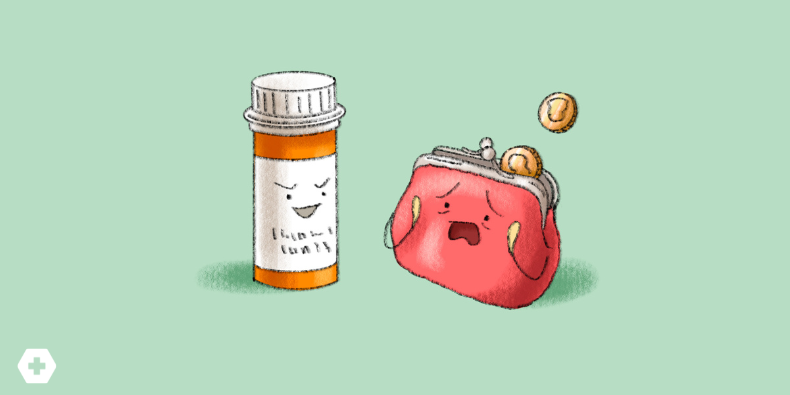
Managing Financial Toxicity with Prescription Drug Costs

Let’s be honest: most of us in healthcare didn’t learn about how much medications actually cost our patients when we trained. The system is opaque, the rules are ever-changing, and even the language is confusing.
But here’s the thing: understanding prescription drug costs is critical to patient care. If patients cannot afford their medications, the unfortunate truth is that they often don’t take them. When patients skip or delay meds, they end up sicker, which leads to more ED visits, hospitalizations, and ultimately higher healthcare costs.
If we want patients to benefit from the incredible therapies we now have, we must acknowledge and address the financial barriers standing in the way.
Defining the Problem: Financial Toxicity
Here’s a breakdown of some key terms:
-
▪️Financial burden: The actual cost a patient pays (e.g. $200/month).
-
▪️Financial distress: The emotional and behavioral toll of those prescription drug costs—like skipping doses or avoiding follow-ups.
-
▪️Financial toxicity: The combined impact of financial burden and distress, which can lead to worse health outcomes.
What Determines Out-of-Pocket Costs?
Most of us have prescribed something thinking it was "covered," only to get a call from the patient saying it cost hundreds of dollars. Even patients with insurance can experience massive financial strain—a phenomenon called under-insurance. It turns out it’s very difficult to predict a patient’s out-of-pocket (OOP) costs. This is determined by a number of different variables:
-
▪️Insurance plan type and deductible (the amount a person must pay out-of-pocket for covered medical expenses before insurance begins to cover costs)
-
▪️Whether the patient has already met their deductible. Patients often must first meet their deductible before either prescription copays or coinsurance kicks in. This means January can be particularly painful for prescription drug costs.
-
▪️Whether the patient pays a copay (flat fee) or coinsurance (percentage of drug cost)
-
▪️The drug's tier on their formulary (lower tier medications are preferred by the insurance and associated with lower cost for the patient)
-
▪️Which pharmacy they use (mail order vs retail, in-network vs out-of-network)
Test your knowledge! A patient with type II diabetes is prescribed liraglutide by their clinician. They have a $300 deductible and have to pay 30% coinsurance for tier 3 medications, which is what liraglutide is on their formulary. The retail cost of liraglutide is $650. What would be the cost of this prescription in January and then in subsequent months?
-
A. $195 in January, then $105 for every subsequent month.
-
B. $405 in January, then $195 for every subsequent month.
-
C. $300 in January, then $135 for every subsequent month.
-
D. $195 in January, and in every subsequent month.
The correct answer is at the end of this post.
Four Tools Patients May Use to Lower Costs
Let’s walk through some of the most common strategies patients use and how to know which one is right for them.
1. Prescription Discount Cards
Examples: GoodRx, SingleCare, BuzzRx
-
▪️Can be used with or without insurance
-
▪️Great for uninsured patients or those facing high generic prescription drug costs
-
▪️Do not count toward deductible or OOP max for insured patients
-
▪️Best for: expensive generic medications
2. Copay Cards from Drug Manufacturers
-
▪️Offset brand-name drug costs for commercially insured patients
-
▪️These work with insurance and count toward a patient’s deductible
-
▪️Not allowed for government-insured patients (Medicare, Medicaid, VA) due to anti-kickback laws
-
▪️Best for: brand-name medications for commercially insured patients
3. Patient Assistance Programs (PAPs)
-
▪️Manufacturer-run, income-based support programs
-
▪️Available to both government-insured and uninsured patients
-
▪️Require paperwork, but can drastically reduce costs
-
▪️Best for: low-income patients needing brand-name medications
4. Discount Pharmacies
Examples: Mark Cuban Cost Plus Drugs, Amazon Pharmacy
-
▪️Cut out the middlemen (pharmacy benefit managers) and pass savings directly to patients
-
▪️Similar to prescription discount cards, but these pharmacies will work with some insurance companies
-
▪️Prices are transparent, often cheaper for generics
-
▪️Best for: expensive generic medications
So, What Can We Do as Clinicians?
Here are three practical actions you can take starting today:
-
1. Get familiar with the dominant formularies in your clinic
If most of your patients are on Medicaid, VA, or a particular insurer, make sure you know their formulary inside and out. -
2. Screen for financial toxicity just like you would screen for depression
Asking our patients about the financial burden of their medications is a critical first step in assessing medication adherence. If patients can’t afford their medications, they likely aren’t taking them. Ask: “Are any of your medications particularly expensive?” or “Have you ever delayed picking up a prescription due to cost?” -
3. Match the patient to the right savings tool
-
▪️Generic medications too expensive? → Discount card or discount pharmacy
-
▪️Brand-name med + commercial insurance? → Copay card
-
▪️Low-income patient who needs a brand-name medication? → Patient Assistance Program
-
Financial toxicity is real, and it’s critical we help to address it head-on by discussing prescription costs with our patients. Patients who can’t afford their meds don’t take them. That leads to worse outcomes and higher costs later on.
Quiz answer: B. $405 in January, then $195 for every subsequent month.
Explanation: This patient has a $300 deductible, which they will have to meet before the coinsurance is calculated. In January, they will have to pay $300 towards their deductible plus 30% coinsurance, which is calculated against the remaining retail cost of the medication.
$650-$300 = $350 remaining cost of the medication after the deductible
$350 x 0.3 = $105
$300 (deductible) +$105 (coinsurance) = $405 in January
In subsequent months, this patient will not need to meet their deductible again. But they will continue to have to pay a 30% coinsurance for the medication.
$650 x 0.3 = $195
Practice-Changing Education
Experience education that goes beyond theory. Explore Hippo Education’s offerings below.


